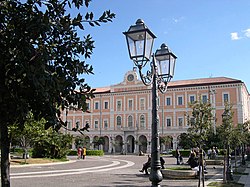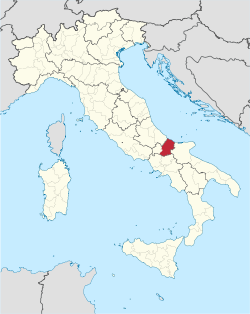Campobasso Province
| Province of Campobasso | |
|---|---|
| Province | |

Campobasso
|
|
 Map highlighting the location of the province of Campobasso in Italy |
|
| Country |
|
| Region | Molise |
| Capital(s) | Campobasso |
| Comuni | 84 |
| Government | |
| • President | Rosario De Matteis |
| Area | |
| • Total | 2,925,41 km2 (112,951 sq mi) |
| Population (1 January 2016) | |
| • Total | 225,622 |
| • Density | 0.77/km2 (2.0/sq mi) |
| Time zone | CET (UTC+1) |
| • Summer (DST) | CEST (UTC+2) |
| Postal code | 86100, 86010-86049 |
| Telephone prefix | 0874, 0875 |
| Vehicle registration | CB |
| ISTAT | 070 |
The Province of Campobasso (Italian: Provincia di Campobasso; Molisan dialect: Pruìnge de Cambuàsce) is a province in the Molise region of southern Italy. Its capital is the city of Campobasso.
It covers an area of c. 2,941 square kilometres (1,136 sq mi) and has a total population of 225,622 (2016). There are 84 comunes (Italian: comuni) in the province (see Comunes of the Province of Campobasso).
The eastern part of the province is home to a small Croatian minority who speak an archaic dialect of the Croatian language. The Croatians reside primarily in Acquaviva Collecroce, San Felice and Montemitro.
The Samnites, a group of Sabellic tribes, dominated this region of Italy including Campania from around 600 B.C. to 290 B.C. Following the war against Rome in 343 B.C., in 290 B.C. the territory of the ancient Sannio region (the central zone of which lies in the current province of Campobasso) was included in the Roman Regio IV Samnium. In 570, following an invasion by the Lombards, the territory was annexed to the Lombard duchy of Benevento, resulting in a reduction of the estates and assets of the ecclesiastical bishoprics of Bojano, Saepinum, Venafro, Trivento, Isernia, Larino and Termoli. As a result of frequent changes in its ownership, the Lombards called the city Campus Vassorum (Vassals' Territory) which later became Campobasso. The feudal lords increasingly gained power at the expense of the church. The principality of Capua, established in 860, included the counties of Venafro, Larino, Trivento, Bojano, Isernia, Campomarino and Termoli. Hugues I de Molise, Earl of Bojano and Norman feudal lord of Mulhouse (from which derives the name of Molise), implemented a policy to restore the old boundaries to the territories of Sannio in 1053, and finally, thanks to his successor, Hugues II de Molise, Molise was created independently around 1128.
...
Wikipedia
